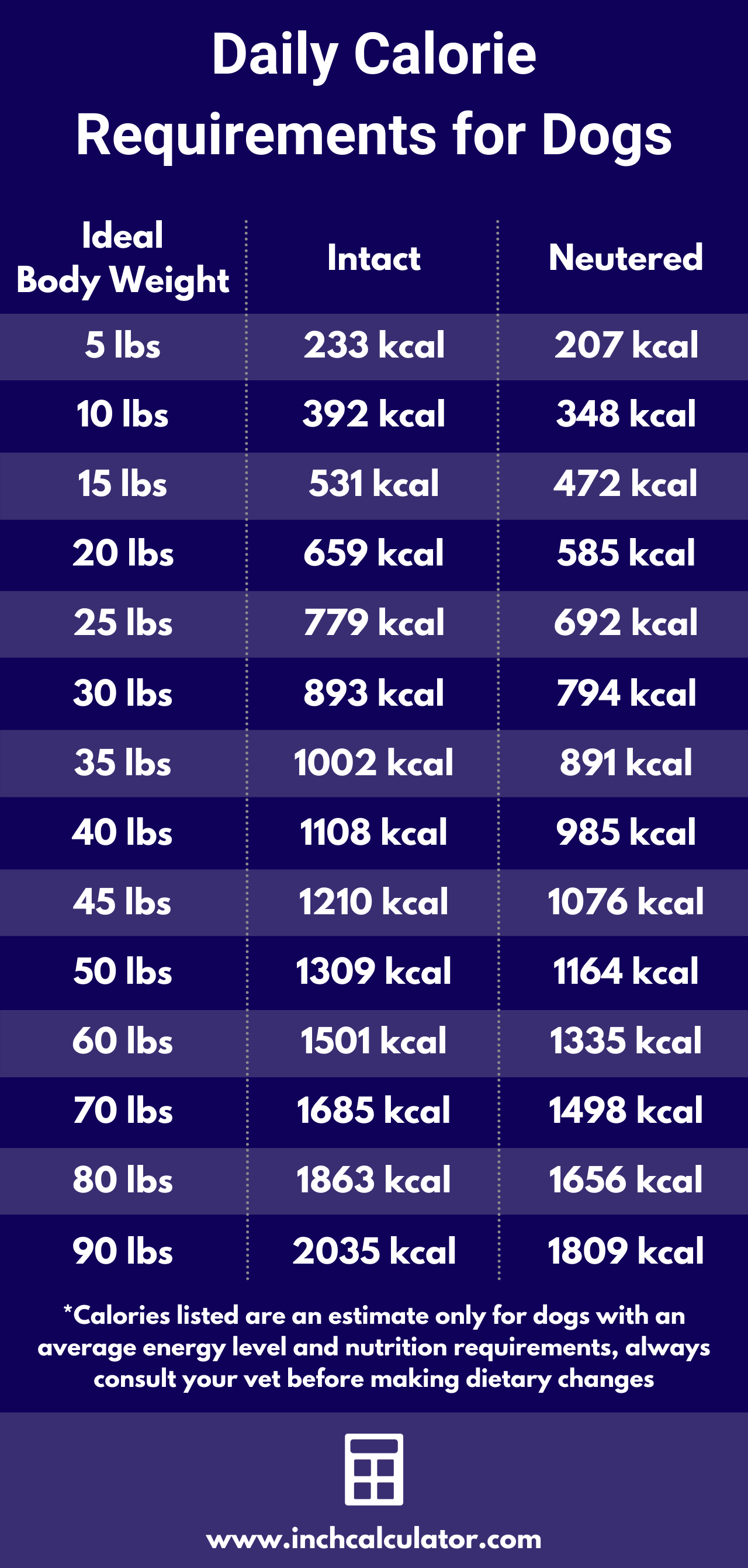Dog Calorie Calculator – How Much Should You Feed Your Dog
Calculate how many calories your dog needs by entering their ideal weight and activity level below.
Dog's Calorie Needs:
Dog Food Needed
On this page:
How to Calculate Dog Calorie Requirements
As a dog owner, managing your best friend’s nutrition is one of the most important things you can do to maintain their health. It’s an often overlooked part of having a pup in the house, and many of us just guess at how much to feed them.
In fact, a 2018 survey by the American Pet Products Association (APPA) found that a whopping 56% of dogs were overweight or obese.[1] So, it turns out that counting calories isn’t just for people.
You’re probably here because you’re wondering how many calories should your dog eat and how much food do they need each day?
There are several formulas that allow you to estimate your dog’s calorie requirements, but it’s important to keep in mind that there is no mathematical formula that can precisely determine how many calories they need. While there are several widely adopted formulas to calculate calorie needs, the best results are simply an estimate or starting point.[2]
Since every dog and their size, breed, activity, and medical situation is unique, it’s crucial that you and your vet monitor your dog’s nutrition closely and adjust as needed. With that disclaimer out of the way, a great way to estimate the calorie requirements for a dog is to use a formula.
Dog Calorie Formula
The amount of energy a dog needs is measured in calories. The number of calories they need each day is referred to as the maintenance energy requirement.
The maintenance energy requirement, or MER for short, is the amount of energy a dog needs to account for thermoregulation, activity, and exercise,[3] similar to a TDEE measurement for humans.
You can use the following formula to calculate the maintenance energy requirement.
MER = RER × multiplier
The maintenance energy requirement (MER) is equal to the resting energy requirement (RER) times the appropriate multiplier for the type of dog and their activity level. We’ll cover how to find both of these next.
How to Find the Resting Energy Requirement
The resting energy requirement (RER) is the energy required for basic body functions at rest, not including activity and exercise, similar to the BMR measurement for humans. You can find the resting energy requirement using the following widely adopted formula:[4]
RER = 70 × weightkg0.75
The resting energy requirement (RER) is equal to 70 times the dog’s ideal weight in kilograms to the 0.75 power. Hint: use our exponent calculator to find the 3/4 power for this equation if needed. This formula is commonly used to find RER and is also referred to as Kleiber’s Law.
It’s important to note that the weight for this formula is the dog’s ideal weight, not their current weight. If you are not sure what your pet should ideally weigh, as your veterinarian for assistance.
How to Find the Maintenance Energy Requirement
In addition to the RER, you’ll also need an adequate multiplier to account for some of the animal’s characteristics such as activity or age which influence their energy needs. The table below includes some commonly used estimates for energy requirement multipliers for use with the calorie formula above.[5]
| Dog Type | MER Multiplier |
|---|---|
| Puppies | |
| < 4 months old | 3.0 |
| > 4 months old | 1.8-2.5 |
| Adults | |
| typical intact | 1.8 |
| typical neutered/spayed | 1.6 |
| lightly active (light work) | 1.6-2.0 |
| moderately active (moderate work) | 2.0-5.0 |
| very active (heavy work) | 5.0-11.0 |
| sedentary | 1.0 |
| overweight or obese-prone | 1.2-1.4 |
| senior | |
| Reproduction | |
| pregnant first/second trimester | 1.8 |
| pregnant third trimester | 3.0 |
| lactating | 4.0-8.0 *depends on the number of nursing puppies |
You can combine the RER, MER, and multipliers for a more complete formula to calculate a dog’s calorie requirements.
calories required = 70 × ideal weightkg0.75 × multiplier
This is the formula that the calculator above uses.
| Ideal Body Weight | Intact | Neutered/Spayed |
|---|---|---|
| 5 lbs | 233 kcal | 207 kcal |
| 10 lbs | 392 kcal | 348 kcal |
| 15 lbs | 531 kcal | 472 kcal |
| 20 lbs | 659 kcal | 585 kcal |
| 25 lbs | 779 kcal | 692 kcal |
| 30 lbs | 893 kcal | 794 kcal |
| 35 lbs | 1002 kcal | 891 kcal |
| 40 lbs | 1108 kcal | 985 kcal |
| 45 lbs | 1210 kcal | 1076 kcal |
| 50 lbs | 1309 kcal | 1164 kcal |
| 60 lbs | 1501 kcal | 1335 kcal |
| 70 lbs | 1685 kcal | 1498 kcal |
| 80 lbs | 1863 kcal | 1656 kcal |
| 90 lbs | 2035 kcal | 1809 kcal |

How Much Food Does Your Dog Need
Now that you have a basic understanding of how to find the energy needs of your dog, you can more easily figure out how much food they need. You can calculate how much to feed your dog by dividing the total amount of calories they need each day by the number of calories in each serving of their food.
cups of dog food = total daily calories / calories per cup
The number of cups of dog food is equal to their total daily calorie requirement divided by the calories per cup of food. It’s crucial to note that each dog food product is different and has different nutritional value and energy per cup. The standardized nutrition label on pet food must include the calorie statement, which is what you should refer to when performing this calculation.[6]
Most dogs eat two meals per day, so you’ll need to divide the number of cups by the number of feedings to determine how much to give them for each meal.[7] Note that you should always consult your veterinarian when planning your dog’s diet plan and feeding schedule.
How Much Food Does a Puppy Need
The nutritional needs for a puppy are a little different than those for an adult since they are growing significantly in their first year of life. Consult your vet and use the multipliers for puppies in the table above to get a better estimate of how much food they’ll need.
Puppies might also need to eat much more frequently than adults; some eat three or more meals per day. It’s important to divide the total calories needed per day by the number of meals to make sure you’re giving your puppy the correct amount of food. And, as mentioned above, it’s important to monitor your puppy’s growth with your vet and adjust their diet and calorie consumption accordingly.
In addition to the proper nutrition, it’s also important that your dog or puppy gets enough water to stay healthy and hydrated.
References
- Association for Pet Obesity Prevention, 2018 Pet Obesity Survey Results - U.S. Pet Obesity Rates Plateau and Nutritional Confusion Grows, https://www.petobesityprevention.org/2018
- Coates, J. DVM, Are You Feeding Your Dog the Right Amount?, PetMD, August 30, 2013, https://www.petmd.com/blogs/nutritionnuggets/jcoates/2013/aug/how-many-calories-does-dog-need-30849
- Mullis, R., Witzel, A., & Price, J., Maintenance energy requirements of odor detection, explosive detection and human detection working dogs, PeerJ, 2015, 3, e767. https://www.ncbi.nlm.nih.gov/pmc/articles/PMC4349026/
- Kleiber, M., The fire of life. An introduction to animal energetics, 1961, xxii + 454. https://www.science.org/doi/10.1126/science.134.3495.2033.a
- Lumbis, R., Nutritional calculations: a guide for the veterinary healthcare team, The Veterinary Nurse, October 2, 2014, https://www.theveterinarynurse.com/review/article/nutritional-calculations-a-guide-for-the-veterinary-healthcare-team
- Reisen, J., How to Read a Dog Food Label, American Kennel Club, https://www.akc.org/expert-advice/nutrition/how-to-read-a-dog-food-label/
- Coates, J. DVM, Are You Feeding Your Dog the Right Amount?, PetMD, May 5, 2020, https://www.petmd.com/dog/nutrition/are-you-feeding-your-dog-right-amount


